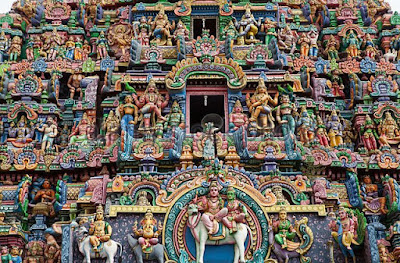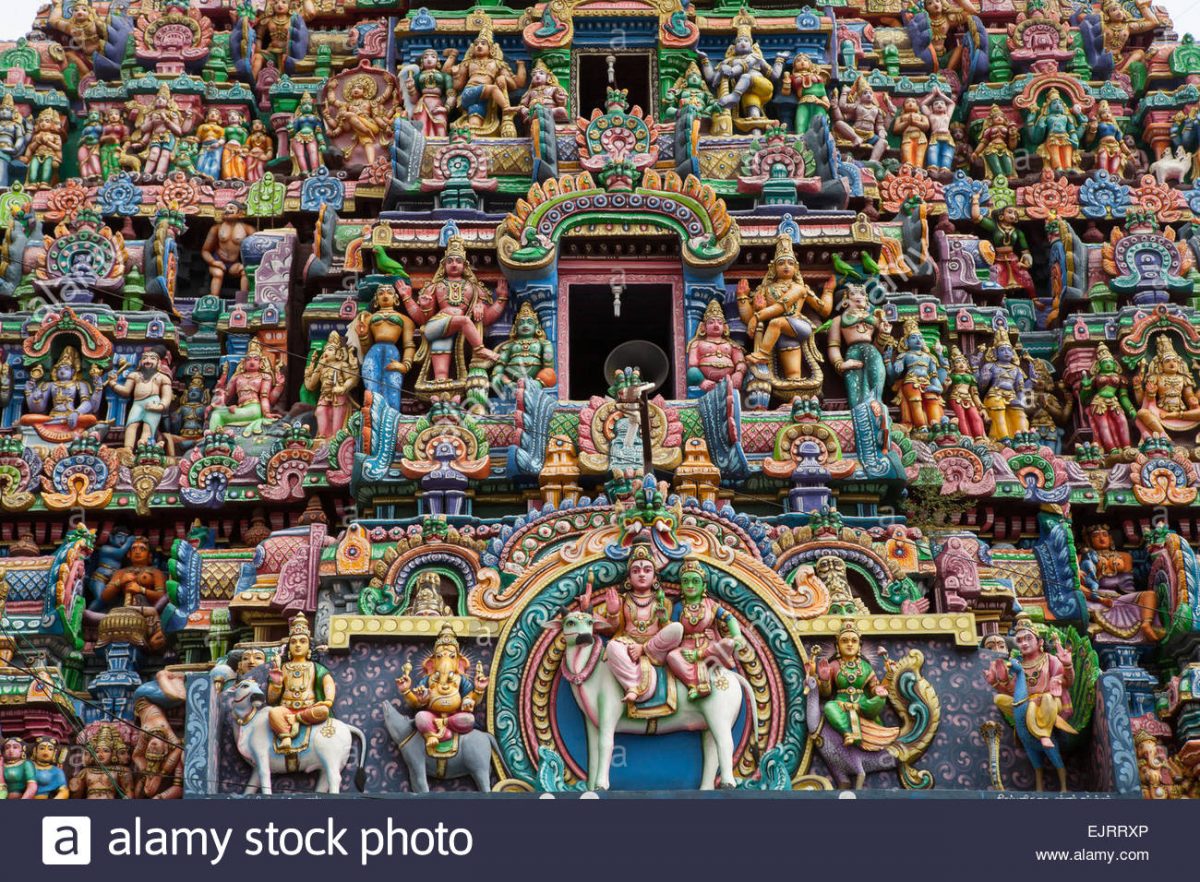ॐ श्री गुरुभ्यो नमः ॐ श्री शिवानन्दाय नमः ॐ श्री चिदानन्दाय नमः
Source of all Images in this Blog-post : Google Images : ‘Google Image Search’ will reveal the multiple sources of every single image shared in this Blog. For more details, kindly see ‘Disclaimer‘
Official Website of Shri Adi Kumbeshwarar Temple, Kumbakonam
Explore Kumbakonam Adi Kumbheshwarar Temple on TripAdvisor
Read Reviews on Kumbakonam Adi Kumbheshwarar Temple on TripAdvisor


Adi Kumbeswarar Temple, Kumbakonam is a Hindu temple dedicated to the Hindu God Shiva, located in the holy town of Kumbakonam in Thanjavur District Tamil Nadu, India.
Shiva in this temple is worshiped as Adi Kumbeswarar, and is represented by the lingam. His consort Parvati is depicted as Mangalambigai Amman.
The presiding deity is revered in the 7th century Tamil Saiva canonical work, the Tevaram, written by Tamil saint poets known as the Nayanmars and classified as Paadal Petra Sthalam.
The temple complex covers an area of 30,181 sq ft and houses four gateway towers known as Gopurams. The tallest is the eastern tower, with 11 stories and a height of 128 feet.
The temple has numerous shrines, with those of Kumbeswarar and Mangalambigai Amman being the most prominent.
The temple complex houses many halls; the most notable is the sixteen-pillared hall built during the Vijayanagar period that has all the 27 stars and 12 zodiacs sculpted in a single stone.
The temple has six daily rituals at various times from 5:30 a.m. to 9 p.m., and twelve yearly festivals on its calendar.
The Mahamaham festival takes place once every twelve years during the Tamil Month of Masi (February – March). This is the time when millions of pilgrims from various parts of India visit Kumbakonam to take a holy dip in the sacred Mahamaham tank which is located in the heart of the holy town.
The present masonry structure was built during the Chola dynasty in the 9th century, while later expansions are attributed to Vijayanagara rulers of the 16th century.
The temple is maintained and administered by the Hindu Religious and Charitable Endowments Department of the Government of Tamil Nadu.
Legend
It is believed that the name of the town Kumbakonam is derived from the legend associated with Kumbeswarar Temple. Kumbakonam, roughly translated in English as the ‘Jug’s Corner, is believed to be an allusion to the mythical pot Kumbha of the Hindu god Brahma that contained the seed of all living beings on earth.
The Kumbha is believed to have been displaced by a Pralaya (dissolution of the universe) effected by the Hindu god Shiva‘s arrow and ultimately came to rest at the spot where the town of Kumbakonam now stands.
The nectar is believed to have fallen in two places – the Mahamaham tank and the Potramarai tank. This event is now commemorated in the Mahamaham festival held every 12 years.
Kumbakonam was also formerly known by the Tamil name of Kudamukku. Kumbakonam is also identified with the Sangam age settlement of Kudavayil.
Architecture
Kumbeswarar temple complex covers an area of 30,181 sq ft and houses four gateway towers known as Gopurams. The tallest is the eastern tower, with 11 stories and a height of 128 feet.
The temple is approached by a corridor 330 ft long and 15 ft wide. There are five silver-plated chariots in the temple used for carrying the temple deities during festive occasions.
The temple is the largest Shiva temple of Kumbakonam and has a 9-storeyed Rajagopuram (gateway tower) 125 ft tall. It is spread over 4 acres of land in the centre of the town.
The temple has 3 concentric compounds, elongated along an east–west axis has triple set of Gopurams.
Adi Kumbeswarar is the presiding deity of the temple and the shrine is located in the centre.
Kumbeswarar is in the form a Lingam believed to have been made by Shiva himself when he mixed nectar of immortality and sand.
Manthrapeeteswari Mangalambika is his consort and her shrine is present parallel to the left of Kumbeswarar shrine.
The temple has a colonnaded hall and a good collection of silver Vahanas (sacred vehicles used to carry deities during festival processions)
Beyond the flagstaff, a hallway whose columns feature painted brackets representing Yali (a mythological creature) leads to the Gopuram.
The Navarathiri Mandapam (Hall of Navrathri celebration) has 27 stars and 12 Rasis (constellations) carved in a single block.
The idol of Subramanya having six hands instead of 12, stone Nadaswarams (pipe instrument) and Kiratamurti are main attractions of the temple.
The central shrine of the temple houses the image of Adi Kumbheswarar in the form of Lingam. The shrine of Mangala Nayaki is located parallel to the left of Kumbeswarar, and Somaskanda is located to the right.
The images of Nalvars (Appar, Sambanthar, Sundarar and Manickavasagar), images of the sixty three Nayanmars, Virabhadra, Saptakannikas, Visalakshi, Visvanatha, Valam Chuzhi Vinayaka, Bhikshatana, Karthikeya, Annapurani, Gajalakshmi, Mahalakshmi, Saraswathi, Jasta Devi, Durga, Chandikesa, Kuratirtha, Arukala Vinayakar, Nandi, Bali peetham, Sabha Vinayaka, Kasi Visvanatha, Nataraja are located in the first precinct around the Sanctum.
The temple also has images of Navaneetha Vinayaka, Kiratamurti, Bhairava, Jvarahareswara, Chaota Sri Govinda Dikshits-Nagammal, Chandra, Surya, Adikara Nandhi (the sacred bull of Shiva), Vallabha Ganapathi, Shanmukha, Navagraha (nine planetary deities), Nandhi, Lakshmi Narayana Perumal, Mutra Veli Vinayaka, Bala Dandayutapani, Nandhi, Vanni Vinayakar, Kumbha Munisiddhar, Kumarappar, Adilinga and Sattananthar.
Chamber of repose, decoration hall, Sacrificial hall, grand kitchen, marriage hall, elephant shed, Vasantamandapam, cattle shed, garden and four-pillared hall are other notable parts in the temple.
The flag mast is located in the second precinct, directly on the axis of the presiding deity.
The Mahamaham tank, Potramarai Tirtha, Varuna Tirtha, Kasyapa Tirtha, Chakkara Tirtha, Matanga Tirtha and Bhagavad Tirtha (bathing Ghats along the river Cauvery) are the seven outlying water bodies associated with the temple.
Mangala Kupam Asva, Naga tirtha, Kura tirtha are the three wells, while Chandra tirtha, Surya tirtha, Gautama tirtha and Varaha tirtha are the four tanks located inside the temple.
The Potramarai tank separates the Kumbeswarar temple from Sarangapani temple.
Festivals
The Mahamaham festival takes place once every twelve years during the Tamil Month of Masi (February–March).
This is the time when Lakhs of pilgrims from various parts of India visit Kumbakonam to take a holy dip in the sacred Mahamaham tank which is located in the heart of the town.
The festival has archaeological and epigraphical evidence.
Tulapurushadaram, the practise of weighing oneself against gold and donating to the temple was effected by Govinda Dikshitar and the funds were utilised for funding the construction of the 16 Mandapas around the tank.
Krishnadeva Raya (1509–1529 CE) is believed to have witnessed the Mahamaham festival during this time. That he made donations to the temple on this occasion is found in another inscription.
Twelve Shiva temples are connected with Mahamaham festival which takes place once in every 12 years in Kumbakonam.
These twmples are Kasi Viswanathar Temple, Kumbeswarar Temple, Someswarar Temple, Nageswaran temple, Kalahasteeswarar Temple, Gowthameswarar Temple, Kottaiyur Kodeeswarar temple, Amirthakalasanathar Temple, Banapuriswarar Temple, Abimukeswarar Temple, Kumbakonam, Kambatta Visvanathar Temple and Ekambareswarar Temple.
A few YouTube Videos on Sri Adi Kumbeswarar Temple, Kumbakonam
